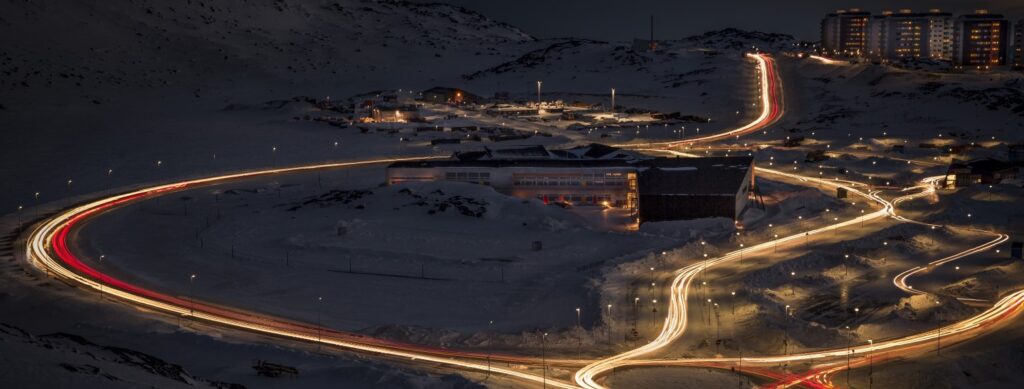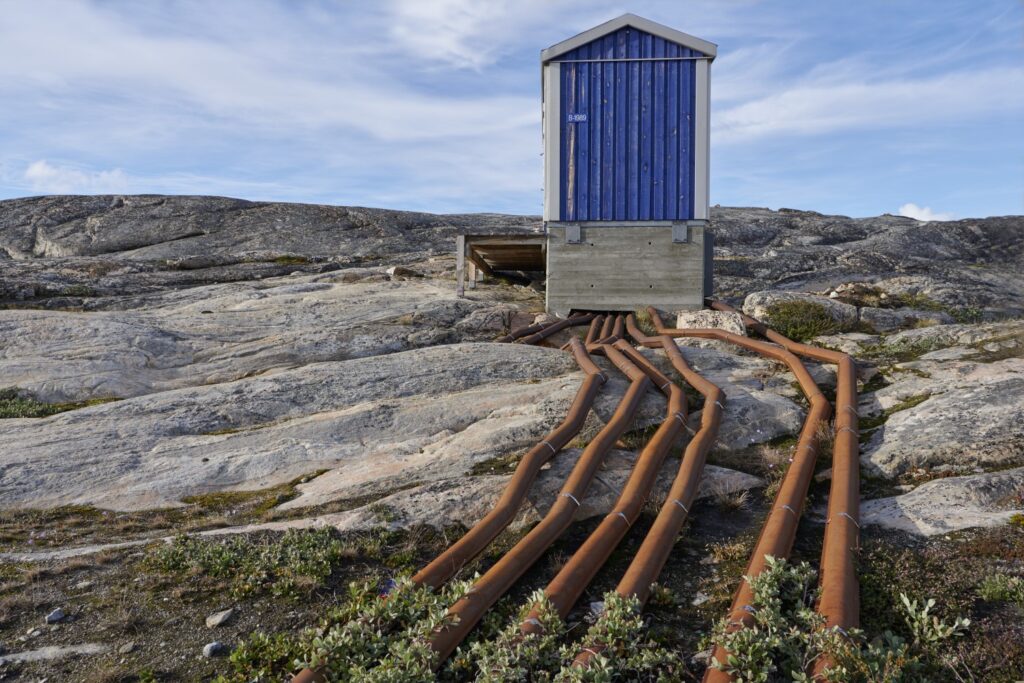
MORTEN RASMUSSEN/BIOFOTO/RITZAU SCANPIX, 2020
The Greenlandic infrastructure is significantly different in several areas than in Denmark and most other countries because Greenland’s towns and settlements function as insular communities.
Due to the climate, permafrost and the wide and deep fjords, and because more homes are located on islands, establishing long road connections is complicated and very expensive. These are challenges that also exist elsewhere where a connected road network has been established to some extent. However, for Greenland, the challenges, combined with the very small population spread over a vast area of land, have meant that no inhabited places are connected by road to other inhabited places, apart from a few sheep farms in South Greenland. It is therefore not possible to commute on a daily basis and the individual settlement is largely dependent on their own business base.
Supply infrastructure
The government-owned limited company, Nukissiorfiit, supplies electricity and water to towns and settlements, as well as district heating to some homes in most towns.
Electricity supply
For Nukissiorfiit, the great distances and the insular community mean that there is no nationwide or regional electricity grid, which is why each town and settlement have their own electricity supply. The only exception are the towns of Narsaq and Qaqortoq in South Greenland, both of which get electricity from the Qorlortorsuaq hydropower station. In addition, there are hydropower stations at Nuuk, Sisimiut, Ilulissat and Tasiilaq. Renewable energy from hydropower accounted for 67 % of Greenland’s electricity consumption in 2018. The power stations in all other towns and settlements are operated with diesel generators.
District heating
In most towns, Nukissiorfiit provides district heating based on residual heat from the electric power station; in some places, the incineration plant also supplies heat. In towns supplied by hydropower, some residential areas are heated with electric heating.
The country’s other homes are heated by oil-fired boilers or, especially for smaller homes, the widely used kerosene heaters. Large multistorey housing blocks or terraced house areas often have a communal heat station.
Water supply
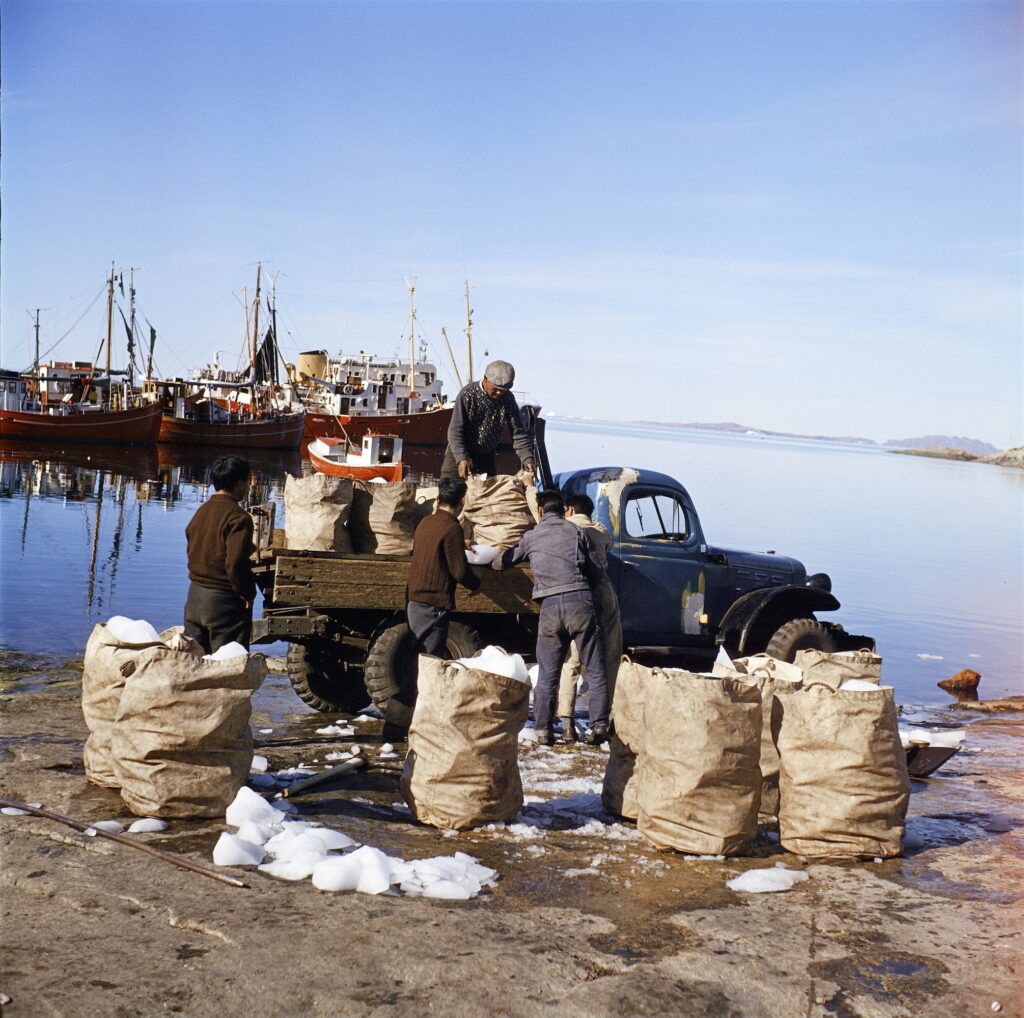
GEORG JENSEN/ARKTISK INSTITUT, 1963‑65
In the vast majority of settlements, Nukissiorfiit uses surface water from one or more nearby lakes, while river water is used in some places. The water is purified and treated in a local waterworks.
In winter, about ten settlements, primarily in North and East Greenland, get their water from tanks that are filled during summer. In addition, there are about ten towns and smaller settlements on small islands that wholly or partially use reverse osmosis (RO) for seawater desalination.
In the large towns, the majority of homes are connected to a water network, and most homes without a water connection get water delivered by a tanker to a water tank in the home. In the small towns, far from all homes are connected to a water network, and in the settlements very few households have a connection to a water system. Here, citizens have to fetch water in plastic containers from a tapping house. It is not uncommon that you need to go 500 m to a tap house and, for some settlements, the distance can be longer.
The settlements of Naajaat and Nutaarmiut in Upernavik district and Qeqertat in Qaanaaq district have no water supply. Here, citizens have to fetch water from a river or a lake, and in winter, they have to melt large clumps of ice that are collected on the sea ice.
The limited water resources and/or the absence of a supply network mean that personal water consumption is very modest in many places. Approx. 5 % of the population has an average water consumption of less than 20 litres daily and about 12 % has a consumption below 40 litres. This modest water consumption for cooking, bathing and laundry, etc. affects health and personal hygiene.
Water supply is also important for business development and reduces opportunities for local processing of fish, including in the large Greenland halibut districts of Uummannaq and Upernavik. The Greenland halibut exported from here is therefore largely unprocessed, and the value added by processing does not benefit Greenland. Despite modest water supply in several places, the districts of Uummannaq and Upernavik, measured per capita, contribute above average to national export income.
Price structure
It is cost-intensive to operate the many local power stations and waterworks where several settlements cannot be reached by boat for parts of the year. All piping needs to be kept frost-free with electric heating cables, and many settlements have a modest customer base. In order to ensure equal competition and social conditions geographically, a common price has been adopted politically across the country. This leads to significant cross-subsidisation, where towns with hydropower and large water resources help to finance the operation of the other settlements.
Wastewater
Most towns have a sewer system to some extent, but all towns have residential areas without sewers. In the larger towns, some of the homes not connected to a sewer system have a sludge tank that is emptied by vacuum tankers. The remaining households use the toilet bucket (bag toilets), which are emptied by the collection of latrines. In the smaller towns and small settlements, the majority of homes are not connected to a sewer system. At national level, about a quarter of the households have a toilet bucket.
There is no treatment plant in Greenland, so wastewater is led untreated into the sea. The majority of homes with no connection to a sewer system or sludge tank lead the grey wastewater from the kitchen sink, possibly bath water and washing machine water, out on the ground.
The municipalities are in charge of wastewater management, while Nukissiorfiit is in charge of water supply. The division of responsibilities is instrumental in the limited sewer system in several towns. For example, the municipality has not provided a sewer system for Upernavik – a town with 1,100 inhabitants – because Nukissiorfiit does not provide sufficient water for the operation of a sewer system.
Waste management

ASHLEY COOPER/SHUTTERSTOCK/RITZAU SCANPIX, 2009
Waste management is a municipal task. In all places, waste is collected and temporarily or permanently deposited at the dump (waste landfill). Some larger towns and few settlements have old incineration plants. In several locations, planned incineration of the dump is sometimes carried out. Spontaneous combustion can occur in the waste, which can result in harmful smoke. Due to strong winds and animals rooting around on the dump, scattered waste is often seen in nature and the sea.
In all locations, the intention is for environmentally hazardous waste and scrap metal to be sent to Denmark for treatment. In 2019, the inter-municipal waste company, ESANI, was established. ESANI intends to build new and larger incineration plants in Nuuk and Sisimiut to replace all existing ones, and the plan is to sail all waste suitable for incineration to Nuuk and Sisimiut. Avannaata Kommunia in the north has chosen not to be part of ESANI as it estimated that the waste transport would be too cost-intensive and complicated considering the municipality’s many small settlements that cannot be reached by boat for parts of the year.
According to the Self-Government’s Waste Action Plan 2020‑2031 which was drawn up in 2020, landfills must be phased out and from 2024 emissions from waste incineration must comply with the EU requirements.
Freight
The government-owned Royal Arctic Line (RAL), in cooperation with the Icelandic shipping company, Eimskip, carries out virtually all shipping between Europe and Nuuk. The vast majority of cargo is shipped from and to Denmark. In Nuuk, cargo for the west coast’s other settlements is transhipped to RAL’s smaller ships, and cargo north of Ilulissat is transshipped again in Aasiaat. Cargo for the east coast is transshipped in Reykjavik to a RAL ship built for ice navigation. Cargo transport to the settlements is partly provided by the subsidiary, Royal Arctic Bygdeservice.
Due to sea ice, Uummannaq and Upernavik can usually only be reached by ship from May to December, and Tasiilaq and the settlements on the east coast from May to November. Ittoqqortoormiit on the east coast and Qaanaaq in the north are only called on twice a year. In winter, navigation in Qeqertarsuup Tunua (Disko Bay) is irregular or cancelled due to sea ice, and in South Greenland, the multiyear ice can periodically make navigation difficult or prevent it altogether.
The price for freight is the same across the country, but the handling charge varies and is determined by location, and a handling fee is charged for each transshipment. RAL’s costs vary greatly and are especially high for settlements without a port where the cargo has to be barged in. Therefore, the price structure includes a significant degree of cross-subsidisation. Exports are indirectly subsidised by the fact that freight rates from Greenland are approximately one third of the price of freight to Greenland. To support fish exports, the price for exporting a 20-foot refrigerated container is nearly a tenth of the price of the imports.
Ship passengers
Royal Arctic Line’s subsidiary, Arctic Umiaq Line, operates a passenger ship between Qaqortoq and Ilulissat, calling in nine towns and three settlements. The fare is partially subsidised.
Disko Line (owned by the Danish Topas Rejser) sails between most towns and settlements in South Greenland, Central Greenland and Qeqertarsuup Tunua with small passenger boats subject to a service contract with the Self-Government. During the winter months, Qeqertarsuup Tunua is serviced instead by Air Greenland’s helicopters.
Otherwise, sailing takes place with private boats and dinghies, and in several places it is possible to charter a boat.
Air transport
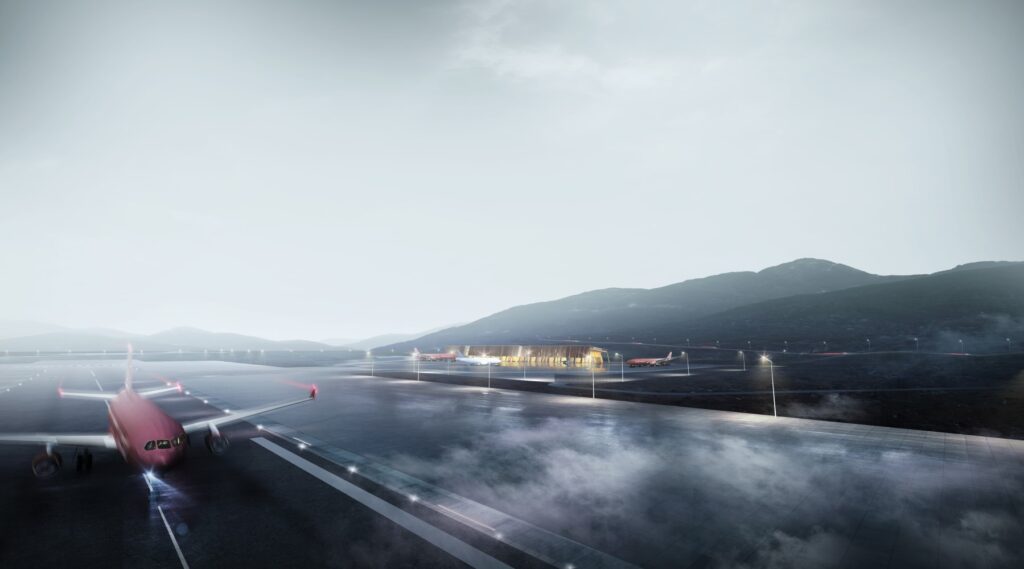
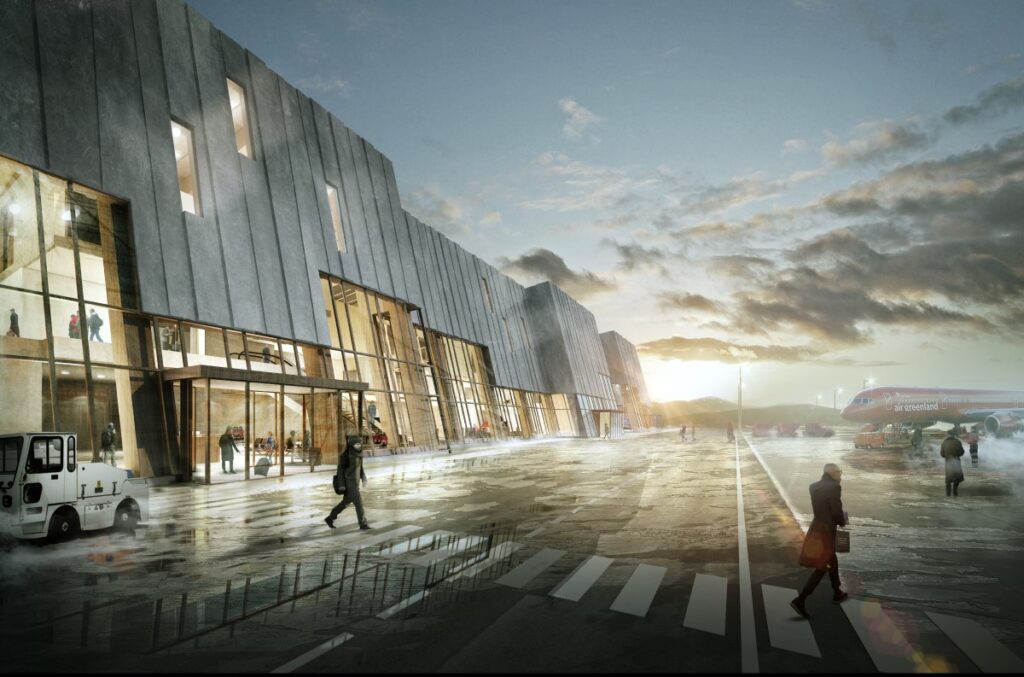

COWI, MASANTI OG ZESO ARCHITECTS, 2018
Greenland’s airports are operated by Mittarfeqarfiit, owned by the Self-Government. The country has two international airports, Kangerlussuaq (Søndre Strømfjord) and Narsarsuaq, with long tarmacked runways capable of receiving transatlantic aircraft. Both were built by the United States during World War II. Kangerlussuaq serves as Greenland’s primary gateway and international airport. It is the hub for domestic flights, while Narsarsuaq is primarily used as a local airport for South Greenland and, in the summer months, connects to Denmark.
In the 1990s, short tarmacked runways were established for small propeller aircraft in the towns of Paamiut, Nuuk, Maniitsoq, Sisimiut, Aasiaat, Ilulissat and Upernavik. The same was the case in the settlement of Qaarsut with a helicopter connection to Uummannaq. Qaanaaq in the north has a gravel runway. On the east coast there is a US built gravel runway by the settlement of Kulusuk with a helicopter connection to Tasiilaq as well as the settlements in Ammassalik district. The Nerlerit Inaat (Constable Point) gravel runway, established by an oil exploration company, has a helicopter connection to Ittoqqortoormiit. Nerlerit Inaat is only served by air from Iceland. The airports have helicopter connections to the remaining towns and most settlements. Most of these towns have heliports with a tower, runway lights and waiting room, while the remaining towns and settlements have more simple helistops. In 13 settlements, Mittarfeqarfiit has no permanent installations.
Air Greenland
Air Greenland flies throughout the year between Kangerlussuaq and Copenhagen Airport several times a week, and in summer also between Narsarsuaq and Copenhagen Airport. For domestic airports, Air Greenland uses smaller propeller aircraft, which are also used on the routes to Reykjavik from Nuuk and Ilulissat. For other destinations, helicopters of different sizes are used.
Flight frequency depends on the size of the place. Nuuk has several daily connections to many destinations, while the smaller towns and largest settlements connect a few times a week. The small settlements with helistops have a weekly connection during periods without ship or boat connection, while settlements without helistops do not have regular service.
The Self-Government subsidises the flight operations for the small towns and settlements. For other routes, Air Greenland uses internal cross-subsidisation where, primarily, the route between Kangerlussuaq and Copenhagen and to a lesser extent the route between Nuuk and Kangerlussuaq help to finance routes with smaller passenger bases. Despite subsidies and cross-subsidisation, domestic flights over longer distances are very expensive.
Regularity
Regularity is affected by the Arctic weather and there are often long delays or cancellations. In order to make optimal use of capacity, priority is given to larger destinations. It is therefore not uncommon for smaller destinations to not be served despite good weather because the aircraft get weather-bound in one of the larger towns.
Air Iceland Connect and Norlandair
The only other companies with permanent routes to Greenland are Air Iceland Connect, which has flights from Reykjavik to Kulusuk, Narsarsuaq, Nuuk and Ilulissat, as well as Norlandair, which has flights from Reykjavik and Akureyri to Nerlerit Inaat.
New airport structure
In Nuuk and Ilulissat, Kalaallit Airports International A/S is constructing new and longer runways (2,200 m) capable of receiving transatlantic jets. The intention is that both runways should be completed by 2024. The plan is that the government-owned Kalaallit Airports Domestic A/S will establish a medium-range runway (1,500 m) in Qaqortoq for domestic and medium-sized aircraft from Iceland and North America. This runway is also expected to be completed in 2025.
Ports and roads
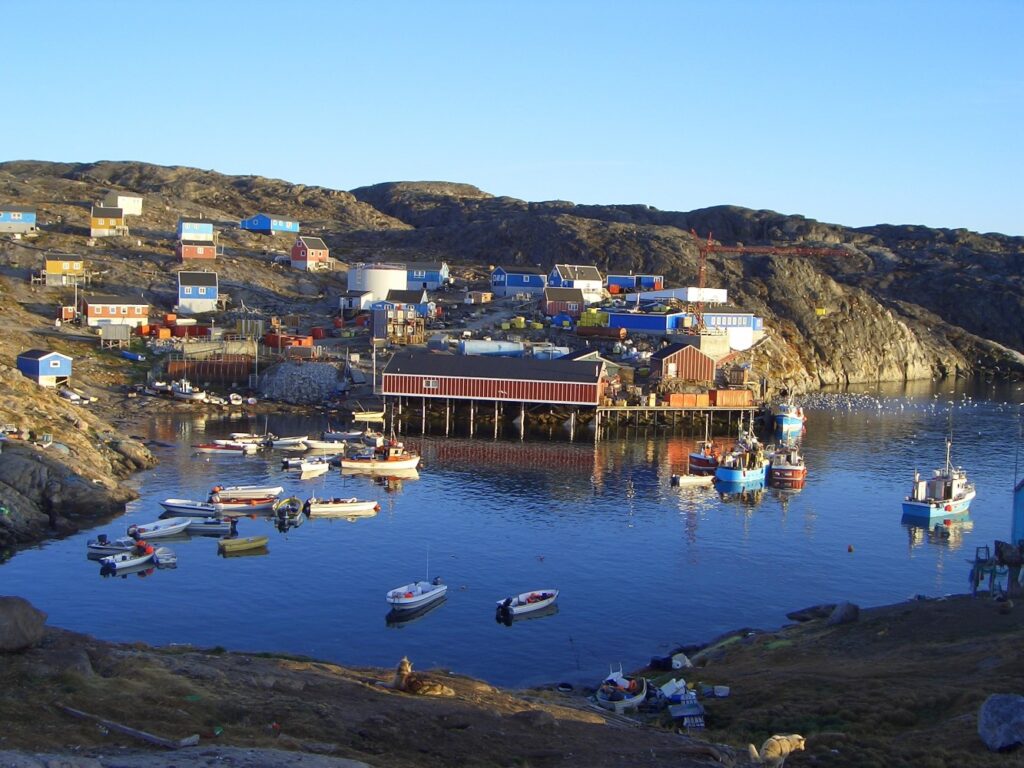
KÅRE HENDRIKSEN, 2019
The Self-Government owns the 150 port facilities used for freight and landing of fish as well as passenger traffic in most settlements. Royal Arctic Line A/S operates the Self-Government ports in virtually all towns, while KNI Pilersuisoq operates the ports in the other towns and most settlements.
In Ittoqqortoormiit and Qaanaaq, as well as in four settlements, cargo must be barged to a barge offloading bridge. There are three settlements without port facilities where cargo is barged directly to the coast.
Road network
The municipalities are in charge of local road facilities. In the large towns, the majority of roads are paved, while the smallest towns and settlements primarily have gravel roads. A number of small settlements have no roads but only trail systems.
Telephony and Internet

THOMAS RAVNSHØJ JOHANSEN/TUSASS, 2020
Tusass (formerly Tele Post Greenland) is owned by the Self-Government and operates telephony, Internet and mobile connections to virtually all residences.
Greenland is connected internationally via a submarine cable from Qaqortoq to Iceland as well as from Nuuk to Canada. The submarine cable connects Qaqortoq and Nuuk and has been led to Aasiaat via Maniitsoq and Sisimiut. Because large icebergs in Qeqertarsuup Tunua (Disko Bay) often scrape across the seabed, it is not considered feasible to take the submarine cable further north.
All settlements between Nanortalik district in the south and Uummannaq district in the north are connected by an approximately 1,500 km long main radio link with 48 radio relay stations located on mountain peaks. The main radio link has several branches, one of which goes to Upernavik and the district’s settlements in the north.
Qaanaaq, Tasiilaq and Ittoqqortoormiit are connected via satellite, and from Qaanaaq and Tasiilaq small radio links have been established to the settlements. In the areas covered by satellite, the capacity and speed is significantly lower than in towns connected to the submarine cable. The price for mobile telephony and mobile data is the same for all settlements, while fixed broadband has higher tariffs in Qaanaaq and Ittoqqortoormiit.
Further reading
- Coasts
- Education
- Health and care
- Housing
- Hunting and subsistence economy
- Industry and labour market
- Plans in Greenland
- Population and demographics
- Self-Government
- The five regional municipalities
- The Greenlandic insular community
- The sea and the fjords
- The Unity of the Realm and the Danish State
- Towns and settlements
Read more about Society and business in Greenland

